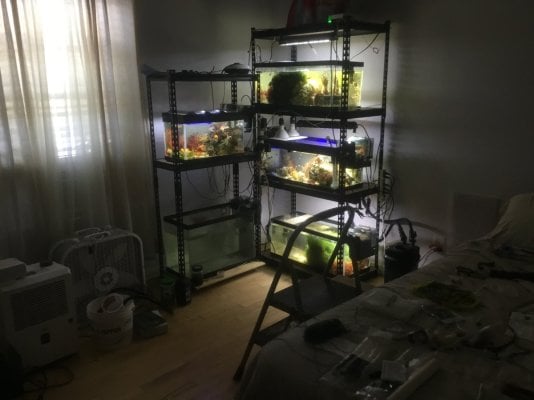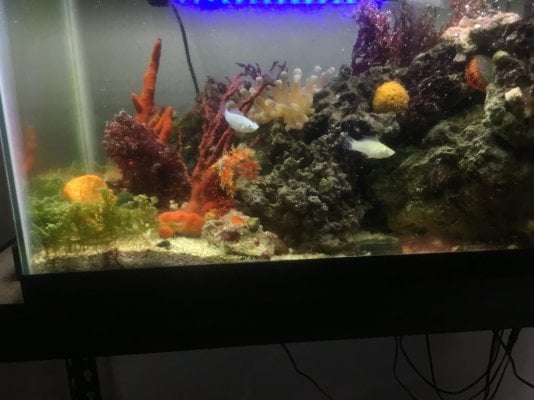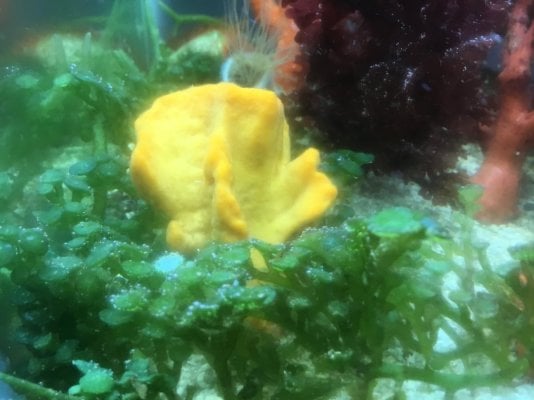Navigation
Install the app
How to install the app on iOS
Follow along with the video below to see how to install our site as a web app on your home screen.
Note: This feature may not be available in some browsers.
More options
You are using an out of date browser. It may not display this or other websites correctly.
You should upgrade or use an alternative browser.
You should upgrade or use an alternative browser.
Please help it’s taking over my tank
- Thread starter campbell80
- Start date
- Tagged users None
And how long did that take to happen?Hi anyone able to identify this & any way to get rid, it’s literally covered every bit of rock in my tank it’s driving me insane!!!!
It has a rubbery texture to it if that helps


Have you tried pulling it off the rock?
Marine Plants In The Aquarium: An online guide to the identification and care of marine plants and macroalgae in the aquarium.
An online guide to the identification and care of marine plants and macroalgae in the aquarium.
www.marineplantbook.com
Hi thanks for taking the time to reply. I started the tank in February with bleach cured rock & live sand. I started noticing small pieces in may & then all of a sudden within the space of about 4 weeks the whole of my live rock was covered. I scrubbed as much as I can off with a tooth brush but couldn’t get into all the nooks and crannies. It’s taken 3 or 4 weeks for it all to come back again. I’ll have a look at the above later to see if I can identify it.
is it hard, or soft? can u pop it(dont try) is it hollow?Hi thanks for taking the time to reply. I started the tank in February with bleach cured rock & live sand. I started noticing small pieces in may & then all of a sudden within the space of about 4 weeks the whole of my live rock was covered. I scrubbed as much as I can off with a tooth brush but couldn’t get into all the nooks and crannies. It’s taken 3 or 4 weeks for it all to come back again. I’ll have a look at the above later to see if I can identify it.
It’s almost feels like rubber, it will squish between you fingers but not pop. No it’s not hollow.is it hard, or soft? can u pop it(dont try) is it hollow?
looks like a sponge to me, might be wrong thoIt’s almost feels like rubber, it will squish between you fingers but not pop. No it’s not hollow.
It's definitely some kind of sponge that has taken over
How far along is this tank? Can you restart?
This is a reason why I like to go with dry rock personally - this looks some kind of thing that came from the ocean and filled a niche because it didn't have any competitors
How far along is this tank? Can you restart?
This is a reason why I like to go with dry rock personally - this looks some kind of thing that came from the ocean and filled a niche because it didn't have any competitors
Weird.. I agree; it may be some kind of sponge, but I am not totally sure. Maybe @ISpeakForTheSeas can help ID.
I looked at the linked identification page earlier and I didn't see a match. I thought the closest match in looks was Hydrolithon but it definitely is not what you have there.I’ll have a look at the above later to see if I can identify it.
Your picture is not clear to me.Hi anyone able to identify this & any way to get rid, it’s literally covered every bit of rock in my tank it’s driving me insane!!!!
It has a rubbery texture to it if that helps


Pull some of it from the rock and lay against white background to better identify.
So, you bleached the rock but not the live sand. If your sand was diver collected from the ocean, you may have introduced hitchhikers. However, almost all live sand in bags means only bacteria inoculated as live.Hi thanks for taking the time to reply. I started the tank in February with bleach cured rock & live sand. I started noticing small pieces in may & then all of a sudden within the space of about 4 weeks the whole of my live rock was covered. I scrubbed as much as I can off with a tooth brush but couldn’t get into all the nooks and crannies. It’s taken 3 or 4 weeks for it all to come back again. I’ll have a look at the above later to see if I can identify it.
Marine Plants in the Aquarium
macroalgae, marine plants, caulerpa, refugium substrate, marine macroalgae for sale
www.marineplantbook.com
From your description of rubbery texture, I think you may have this Caulerpa. I use it for nutrient export as well as an ornamental seaweed in mixed garden filter feeding invert tank.
Attachments
Not a sponge in this case - this is a brown macroalgae of some variety; I would guess one from the order Ectocarpales like Encephalophycus tuberculatus or Colpomenia sinuosa, but I haven't learned enough about brown algae yet to easily distinguish the various species.Weird.. I agree; it may be some kind of sponge, but I am not totally sure. Maybe @ISpeakForTheSeas can help ID.
Some other possibilities (various species from the genera below):
Some things that it could be:
-Asteronema
-Colpomenia
-Leathesia
-Petrospongium
-Sarcinochrysis
Those seem pretty close to target.Not a sponge in this case - this is a brown macroalgae of some variety; I would guess one from the order Ectocarpales like Encephalophycus tuberculatus or Colpomenia sinuosa, but I haven't learned enough about brown algae yet to easily distinguish the various species.
Some other possibilities (various species from the genera below):

Colpomenia sinuosa - Alchetron, The Free Social Encyclopedia
Colpomenia sinuosa, the oyster thief or sinuous ballweed, is a brown alga species in the genus Colpomenia. It is the type species of its genus. It is found throughout South Africa and is widespread around Australia and overseas. C. sinuosa contains the C6C4C6 phenolic compound colpol. Lee, Kyung M

Colpomenia tuberculata (Multi-Agency Rocky Intertidal Network ) · iNaturalist
Now I wonder what eats it.
If iyou want to kill macro algae on your rock, then remove rock and soak for 10 minutes in a 10% solution of 3% peroxide. While out of tank scrub. down with straight peroxide then soak in solution.
vetteguy53081
Well known Member and monster tank lover
View Badges
Partner Member 2024
Excellence Award
Reef Tank 365
RGB
Article Contributor
Tampa Bay Reef Keepers
West Palm Beach Reefer
Hospitality Award
Ocala Reef Club Member
305 Reef Club
Wisco Reefers
Midwest Reefer
Fish Medic
MAC of SW Florida
Rock Pool Reef Keepers
R2R Secret Santa 2023
My Tank Thread
My Aquarium Showcase
THE YELLOW ONE APPEARS TO BE SPONGE BUT NEED CLEARER PIC.. . . Oops on Caps lock/Marine Plants in the Aquarium
macroalgae, marine plants, caulerpa, refugium substrate, marine macroalgae for salewww.marineplantbook.com
From your description of rubbery texture, I think you may have this Caulerpa. I use it for nutrient export as well as an ornamental seaweed in mixed garden filter feeding invert tank.
May be Fiji species such as Taveuni or Leucetta
Last edited:
Haha, I'm not sure - I know some amphipods and the Purple Urchin, Heliocidaris crassispina, will eat Colpomenia, and I've seen speculation that some snails or hermits may eat algae like this as well, but I'm not aware of any large herbivores we commonly keep that confirmedly eat it at the moment.Now I wonder what eats it.
Similar threads
- Replies
- 14
- Views
- 175























